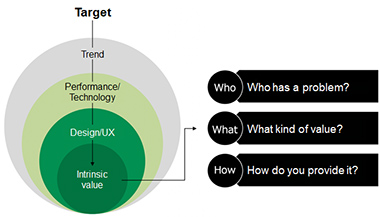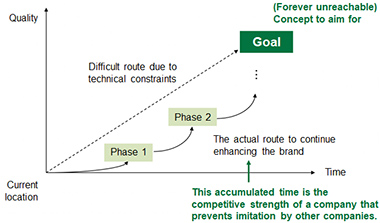What to create rather than how to sell it
When thinking of marketing, many of us may have an image of advertising or running campaigns. However, such an image is the exact opposite of what marketing should be. Marketing is about thinking about what kind of value to create rather than how to sell it.
One of the last things you should do when planning a product or service is to ask consumers what they want, or the answer. Executives such as Henry Ford, Steve Jobs, and Soichiro Honda unanimously said that such market research is meaningless. It is because consumers cannot express what they want for themselves. Consumers are indeed excellent critics, but not good marketers.
In a famous example, if you had asked people what they wanted in the horse-and-buggy days, the answer would have been “a more faster running horse.” It would not have been “a car.” In this manner, consumers can only imagine it as an extension of the performance of existing products. It is a marketer’s job to think about value, and such an act is marketing.
How can we think about value? Simply put, it is thinking about “Are consumers willing to pay the high price to buy it?” What is necessary for that is to solve the practical and psychological problems of consumers. Value comes from problem-solving. For example, if you are in need because you are not feeling well and cannot get over the symptoms and your doctor says that this medicine will cure the symptoms, you will be happy to buy it, even if it is expensive. This is because there is no more practical value than this.
Problem-finding is more difficult than problem-solving

When the economy in Japan was growing rapidly, it was easy to find problems. It was to be unbreakable. Toward a well-defined answer, Japanese companies aggregated their technological prowess to take the world by storm with highly durable consumer electronics and cars.
With products and services now flooding the market, the difficulty in creating value lies in finding problems. There are many potential problems lurking around consumers. However, we will not be able to see at a glance any psychological problems that consumers are vaguely dissatisfied with, put up with, or have resolved in their own way. Discovering such problems is the first step in marketing and the most difficult task.
If we can clearly grasp such problems, the concept to be the significance of the existence of products and services will be clarified. Concept is not about consumer trends or technology/design that is the hot topic in the industry, but about leaving them out of the discussion and defining their intrinsic value. What we should specifically decide is who, what, and how. Among them, the most important element is “who.” We need to clearly picture who has a problem. In such a picture, there is a high value that consumers naturally buy. The reason why there are so many products and services in the world with ambiguous concepts is that companies only focus on what their competitors are doing rather than spending time on this problem-finding. To sell such low-value products, they need to advertise heavily or run discount campaigns. In other words, one could argue that advertising and running campaigns are acts of trying to sell something that is, in a sense, worthless to consumers. Of course, an appropriate level is necessary to gain recognition.
Concept is forever unreachable

How can marketers create value that finds and solves consumers’ problems? In reality, there is no universal method for this. There are all kinds of marketing research and analysis services out there, but to put it in ultimate terms, it does not matter what as long as they could find and solve consumers’ problems.
Therefore, no matter how much technology has advanced and society’s values have changed, what is universally required of marketers is to observe consumers’ activities and psychological situations on a daily basis, and to imagine and find problems based on them. Since there is no way that problems will disappear from this world, they always exist even at this moment. In other words, after objectively understanding things and situations as a third party, we can then subjectively consider the problems from the perspective of the persons involved. That involves imagining and thinking by completely being that person, even if the problem is something we have never experienced on our own. It is impossible for one person to have the experience of everyone, therefore it is essential for marketers to have the ability to imagine even people in situations where marketers have no experience in the past.
As we deepen this thought, we can form our own hypothesis, such as whether there may be such a problem here, and if so, there may be such a solution. By deepening such a hypothesis even further, it can be sublimated into a concept.
Concept in marketing serves to verbalize the value that consumers are willing to pay for (= solving practical and psychological problems) and shares it with the entire company while also making consumers aware of the significance of the existence of products and services. The key to formulating a concept is to recognize that concept is forever unreachable. A concept that is achievable in a short time can be immediately imitated by competitors and is therefore not worth much. Instead, companies can propose solutions to problems that are forever unreachable and consistently raise the level of achievement step by step. This accumulation of time allows the establishment of a brand of goods and services that competitors can never keep up with. It is exactly what Walt Disney said about Disneyland, which sets the theme of the Kingdom of Dreams and Magic, “Disneyland will never be completed. It will continue to grow as long as there is imagination left in the world.”
Science exists to reduce the probability of failure
The concept I have talked about is abstract and therefore difficult to make decisions about. There may be many times when a concept has great value from the consumers’ perspective but does not make sense from the decision-makers’ perspective. This is because it is difficult for them to imagine the value of a novel concept.
This is where scientific verification comes in. The role of scientific verification in marketing is not to guarantee absolute success, but to reduce the probability of failure. Unlike natural science, marketing that targets consumer psychology does not guarantee absolute success. If new products, services, or technologies that will change the current situation are created, or if the values up to the present are pointed out to be socially problematic, the psychology of consumers may become completely different.
However, through verification, it becomes easy to spot a potentially unsuccessful failure. This is extremely important for merchants because it prevents a futile failure before making a major investment. Through an unimpassioned, objective verification, a multitude of options are sifted through, and those with the best chance of success are carefully selected. It is nothing special when put into words, but it is pointed out that there are still few organizations that are executing this process on a routine basis. In particular, it is more important for durable consumer goods makers to understand the possibilities of products at the earliest development, since large -scale investment will be required for producing new products.
Again, we should recognize even during verification that consumers are critics. Please do not throw away a concept immediately after a bad result comes out in a concept verification. It is possible that you have not been able to imagine the concept specifically. Consumers cannot make a proper assessment unless they can specifically imagine what kind of value they can obtain in their daily lives. Therefore, even in the planning stage of a concept, it is necessary to create a mock-up and provide an environment in which value can be simulated.
The essence of marketing is trial and error
In this way, through trial and error while repeating the objective and subjective idea of objectively grasping the situation, subjectively forming hypotheses, and objectively verifying hypotheses, we can formulate the concept and embody it consistently. This trial and error is the essence of marketing.
Excellent marketing companies have a lot of failures. For example, Dyson, a global consumer electronics company, made 5,000 trial-and-error cycles to develop what would become a remarkably successful vacuum cleaner. In contrast, companies with poor value creation capability are extremely afraid of failing and therefore do not perform verification sufficiently. Even after launching products or services onto the market, they vehemently refuse to accept them as a failure by obscuring the results of effect verification. In such a situation, organizations will never learn anything, and they will never reach the problems to be solved and the embodiment to realize.
Although the word PDCA is widely used in business, there are concerns that the term exists only in PowerPoint materials and is not being implemented at all. I highly recommend looking around your office and counting the number of failures that your company has made. You can do marketing only if you encourage failures and admit failures.
Personnel for marketing as well as personnel for AI
The reason behind the declining presence of Japanese companies may be that they are good at tackling problems with answers but lack the knowledge to discover problems because they have not accumulated enough of such experience in the first place.
In recent years, some companies have announced personnel systems that grant preferential treatment to AI and DX (digital transformation) personnel as a way to break the deadlock. Of course, such personnel are important. However, the main role of such experts is to develop the means to embody the concept. As I mentioned earlier, the modern age is the era of a race to find problems. Accordingly, if there are no personnel for marketing who are experts of finding problems, it will be simply a waste of talent. Marketing capability is required to avoid falling into a situation of turning a means into an end.
* The information contained herein is current as of February 2023.
* The contents of articles on Meiji.net are based on the personal ideas and opinions of the author and do not indicate the official opinion of Meiji University.
* I work to achieve SDGs related to the educational and research themes that I am currently engaged in.
Information noted in the articles and videos, such as positions and affiliations, are current at the time of production.

